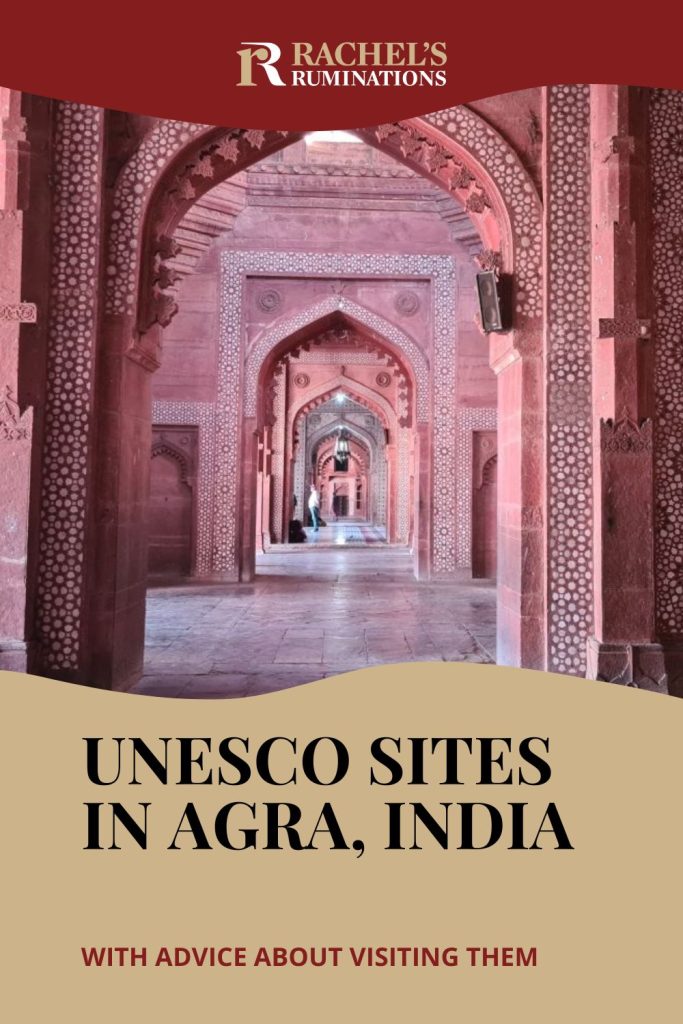Agra UNESCO sites: Which should you visit?
It’s no great surprise that the Taj Mahal is such a popular destination. It is, after all, an absolutely magnificent building. It receives 7-8 million tourists a year, and about 10% of these are from outside India (stats from the Taj Mahal’s website). You can imagine how busy that makes the place, especially in the high season between about October and February.
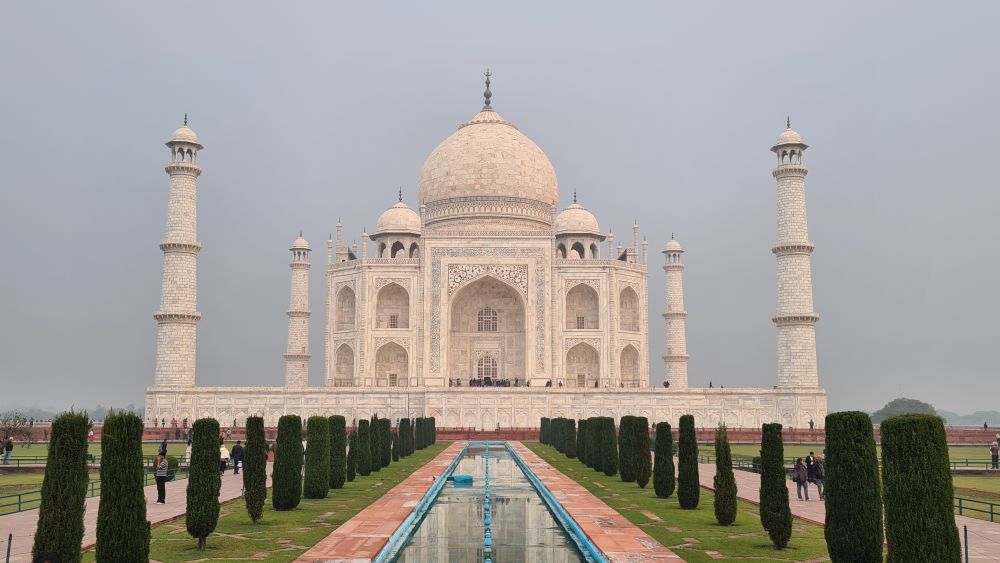
Disclosure: This article contains affiliate links. Making a purchase through an affiliate link will mean a small commission for this website. This will not affect your price.
Foreign visitors often visit the Taj Mahal as part of a so-called “Golden Triangle” tour, which generally includes Delhi, Agra and Jaipur.
It’s not surprising, then, that not only is the Taj Mahal the most visited ticketed monument in India for foreigners, but the two other UNESCO sites in the vicinity of the Taj – Agra Fort and Fatehpur Sikri – come in second and third on the list. People arrive in Agra to see the Taj, but while they’re there, they see the others, rather as an afterthought.
As part of my two-month trip in India, I wasn’t actually that excited to see the Taj Mahal, per se. It just seemed a bit cliche, and I knew it would be crowded with tourists. But I wanted to see as many UNESCO sites as I could while I was in India. Agra Fort is just a few metro stops away from the Taj Mahal, while Fatehpur Sikri is about an hour outside the city. Here are my thoughts and tips on each of these Agra UNESCO sites:
Taj Mahal
Despite my lack of enthusiasm, especially given that we woke up early that day to see the Taj Mahal at sunrise, walking through the entrance gateway – impressive in itself – and seeing that white marble structure in the distance was a real “wow-moment.”
Unfortunately, despite a million travel articles online (including a guest post on this website!) saying that seeing it at sunrise is a way to avoid the crowds, it was crowded. And everyone arriving that morning just stopped walking as soon as they had stepped through the gateway. So did we. Everyone wanted to get that perfect shot of the Taj at sunrise. And then perfect selfies in front of it. And so on.
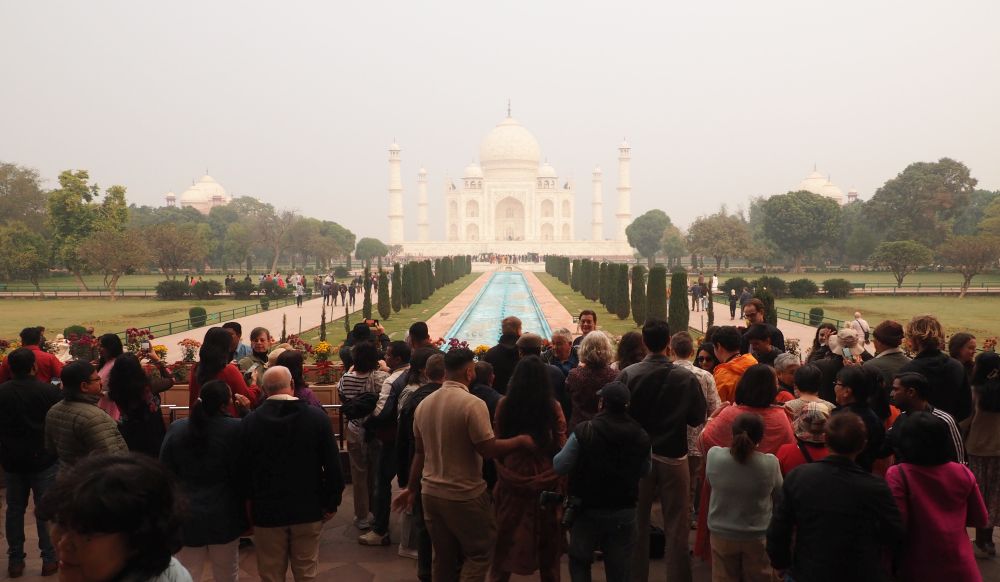
Also unfortunately, it was a cloudy morning, so the sky and the Taj were about the same color. But never mind, it really is a magnificent building.
Background of the Taj Mahal
The Taj Mahal is a mausoleum. Mughal emperor Shah Jahan commissioned it in memory of his wife, Mumtaz Mahal, to serve as her tomb. (She died giving birth to their 14th child!) Construction started in 1631 and the whole complex was completed in 1653.
The building is exactly the same on all four sides, with minarets on each of the four corners. All sorts of artwork covers the surfaces: inlays with different colors of stone and gems, carved stonework, and paint. Mostly it’s abstract forms, nature images and Arabic calligraphy.
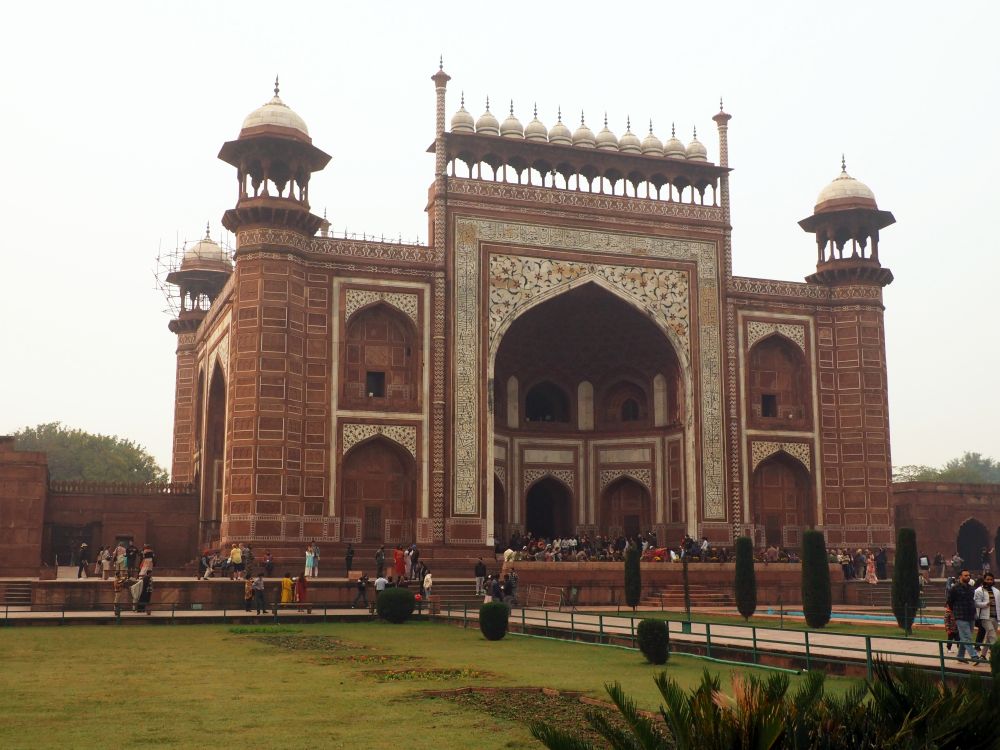
Inside is similarly ornate, with an octagonal, domed center room holding the sarcophagi of both Mumtaz Mahal and that of Shah Jahan himself, which was added when he died later. His sarcophagus is the only thing that is not symmetrical about the structure. Since hers lies in the center, lined up with the entrance gate, his had to be added off-center. The sarcophagi are both decorated with beautiful inlays of flowers and leaves.
Surrounding the tombs are intricately-carved marble screens. By the way, these two sarcophagi are false: the real ones are in a lower chamber below, where they are also asymmetrical and similarly decorated.
Use the map below, centered on the Taj Mahal, to find accommodations in Agra:
The rest of the compound
The photos you generally see of the Taj Mahal, though, don’t do justice to the whole experience. They are almost always only of that white marble mausoleum, which is, indeed, unbelievably beautiful. But there are also gardens around the mausoleum and several other buildings.
The grounds and the buildings are all laid out in perfectly symmetrical alignment. The traditional Mughal garden layout has four squares with pathways and watercourses dividing them. Generally there’s a central fountain. You enter at the East Gate and see the Taj Mahal straight ahead, with a straight and narrow watercourse extending from the gate to the central fountain, surrounding the fountain, and then continuing straight to the base of that marble masterpiece.
It’s hard to look away from that beautiful mausoleum. But to the left and the right are two other gateways facing each other across the symmetrical garden between them, again connected by watercourses in straight lines.
And then, on either side of the Taj are two large buildings: on the left is a mosque, while on the right is an assembly hall. To all appearances, these two buildings are exactly the same. They both face the Taj between them. Both are made of red sandstone with other stones used in their decorative elements, and topped by white domes. If these buildings were anywhere else than next to that exceptional white-marble building, they’d be drawing tourists all by themselves. As it is, tourists see them, but only really as an afterthought.
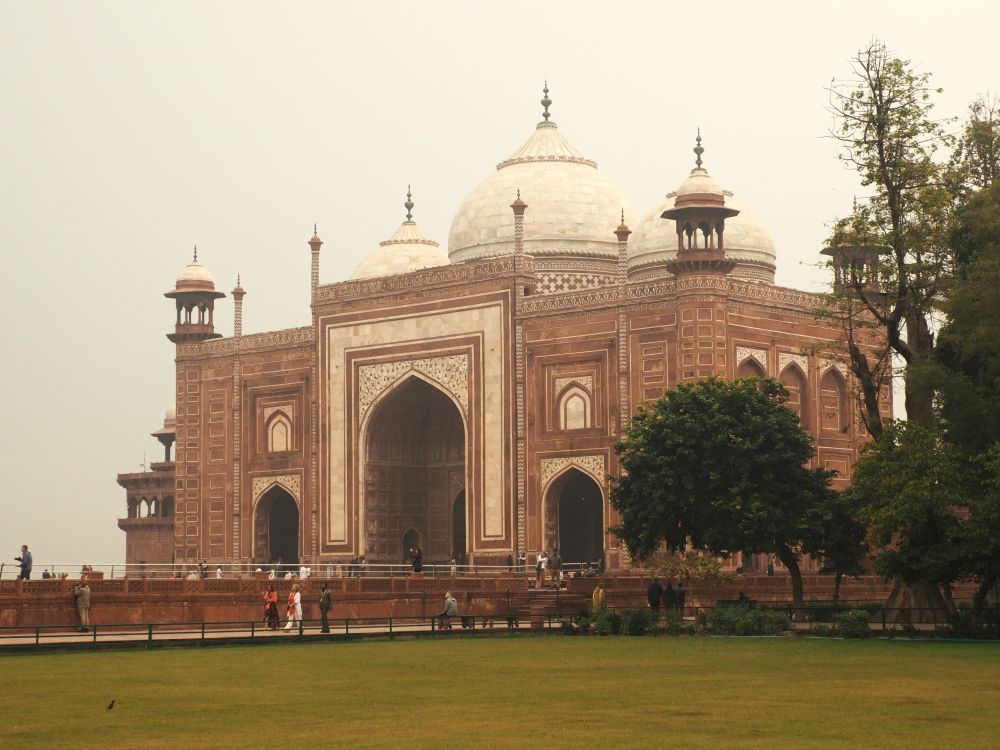
Tips on visiting the Taj Mahal
You’re not going to avoid crowds, but sunrise can be pretty, if it’s a clear morning. You can see the sunset over the Taj from the other side of the river in the park called Mehtab Bagh – incidentally number six on the most-visited-ticketed-monuments-in-India list.
The Taj Mahal, like many other sights in India, is closed on Fridays.
On the night of the full moon and the two days before and after the full moon, you can visit the Taj Mahal at night between 20:00 and midnight for a half-hour only. Book the ticket ahead through this website.
People will approach you to be hired as a guide. Make sure they are government-approved and have an ID card. Agree on the price ahead of time, and say “rupees” so that they can’t turn around and say they meant dollars.
You’re not allowed to bring any food or drink except water into the Taj Mahal complex. If you want to see the inside of the Mausoleum, pay the extra fee at the door.
This is the website for all official information about the Taj Mahal. You can buy your tickets online here to avoid having to wait at the ticket window.
The nearest metro stop to the Taj Mahal is the Taj East Gate station. If you want to visit the Red Fort on the same day, ignore the many tuk-tuk drivers who will hassle you outside, and instead walk to the metro station. Get off at the Dr. Ambedkar Chowk station, where the entrance to Agra Fort is right across the street. It’s far easier, safer, faster and quieter than going by tuk-tuk.
Read more information and advice about the Taj Mahal here.
Agra Fort
The Taj Mahal may be the most well-known piece of Moghul architecture, but Agra Fort is another prime example. If you’re going to be in Agra anyway, don’t miss Agra Fort.
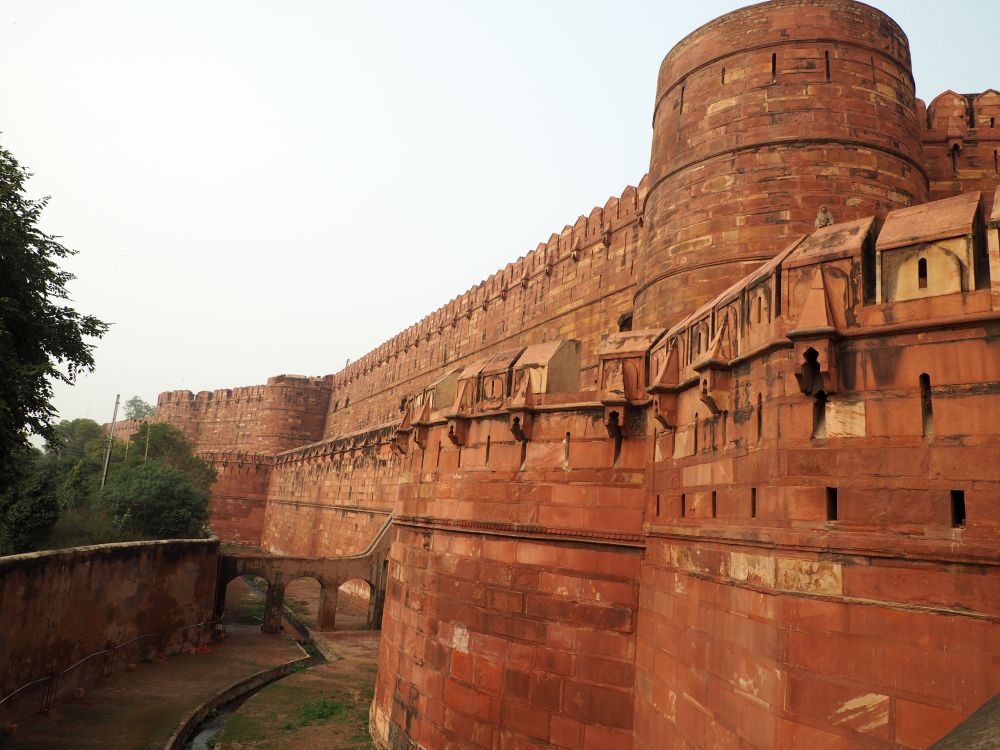
Agra Fort is also mostly a Moghul-period structure, built by Shah Jahan’s grandfather Akbar starting in 1565 on an already-existing fortress. Later, Shah Jahan transformed it into a city of its own within the larger city, with palaces and all that a royal household and court could need. The fortress is semi-circular, more or less, with the straight side along the river. Large parts of the interior are off-limits to visitors because the military still uses them.
Visiting Agra Fort
The size of the red sandstone walls makes an impression as you approach the entrance gate across a large moat. Entering through three large gateways, you’ll wander through a series of courtyards. There’s a red-sandstone palace that Akbar built for his son, Jehangir, plus Shah Jahan’s palace, the Khas Mahal, made of marble.
The Diwan-i-Khas is a large pillared hall used for private audiences. While from a distance it looks like marble, it’s actually red sandstone covered with plaster. Only the throne on which the emperor sat was marble, inset with lots of gemstones, but it’s gone now.
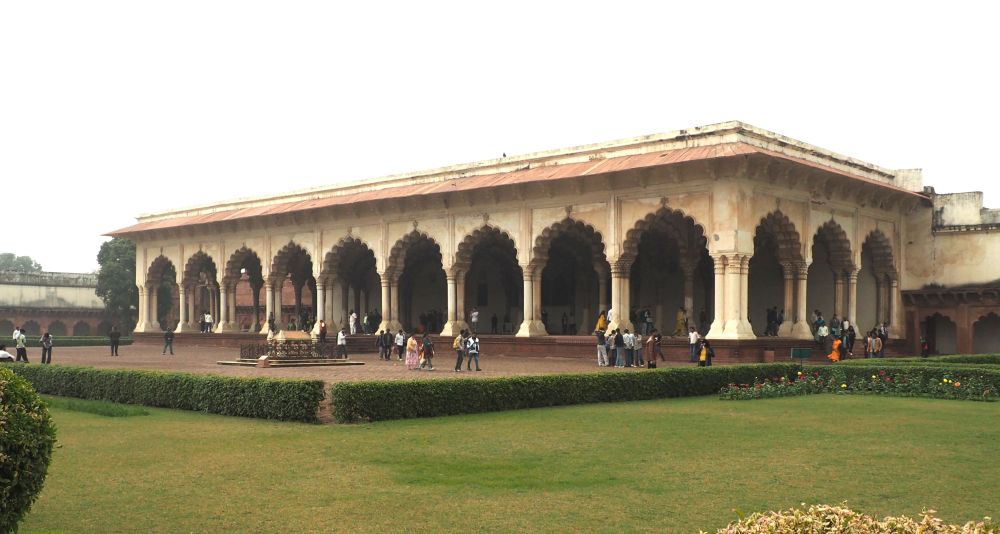
On the same courtyard as Diwan-i-Khas you’ll find the Nagina Masjid, a small mosque for the women of Shah Jahan’s court that is gorgeous with inlaid details.
A pretty courtyard garden called Anguri Bagh had, below it, a series of underground rooms. They’re not open to the public, but that’s where Akbar’s harem of 500 women lived.
There’s plenty more to see, so take your time to walk around.
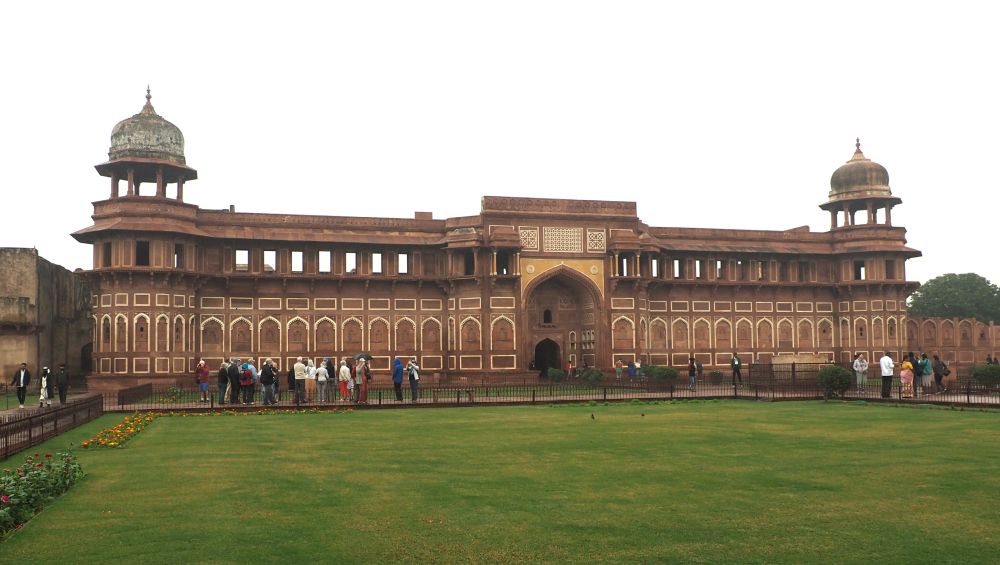
Tips for visiting Agra Fort
There are monkeys that climb around the walls and moat. Stay away: they can be nasty. Don’t feed them and don’t look them in the eye.
Touts will hassle you as you enter and exit the fort. They’ll want you to buy their souvenirs, ride in their tuk-tuks, or hire them as a guide. Ignore them or give them a very firm “No!” and walk away. Don’t give money to children begging – it’s a pattern that should not be encouraged.
As at the Taj Mahal, don’t fall for taking a tuk-tuk if your destination is anywhere near a metro station. The metro is right across the street from the entrance and it’s far more pleasant, faster and cheaper to take the metro than a tuk-tuk. Even if your destination isn’t near a metro station, it might be cheaper to take the metro to the nearest stop, then take a tuk-tuk from there. Make a plan beforehand.
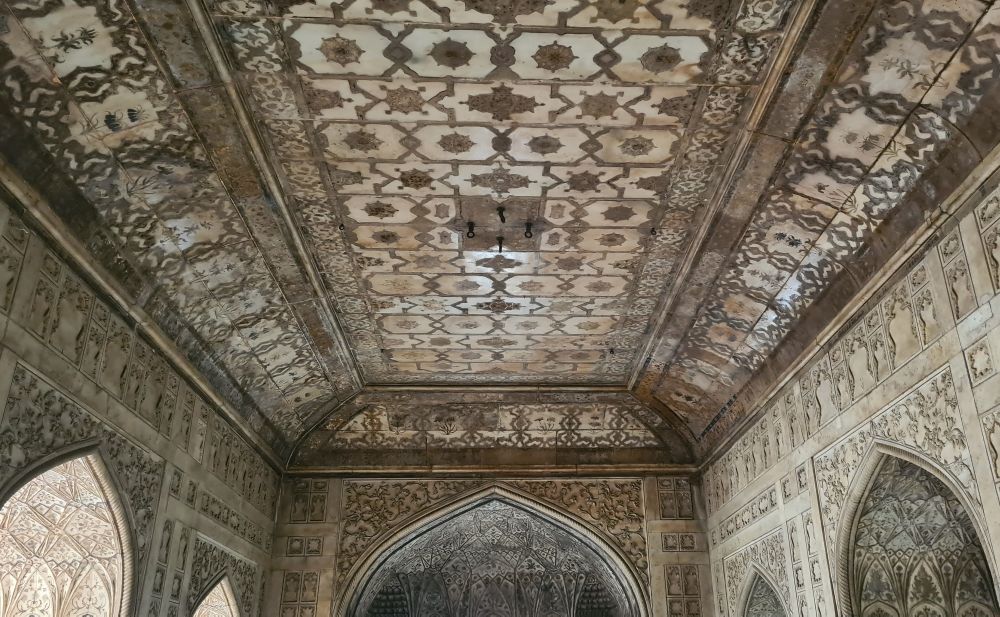
Like at the Taj Mahal, you can’t take any food or drink inside but water.
Buy your tickets ahead of time at this website to avoid waiting in line.
Unlike the Taj Mahal, Agra Fort is open every day.
Fatehpur Sikri
The third – and no less interesting – UNESCO site in Agra isn’t exactly in Agra. It’s about an hour’s drive away. It comes in as number 3 on that list of leading ticketed monuments in India. And to be honest, I liked it better than Agra Fort. This is partly because one section of it is still an active religious place, and partly because it was a lot less crowded when we visited it.
History of Fatehpur Sikri
This whole fortified city was built in a space of just 13 years, from 1572 to 1585, by order of Emperor Akbar. What happened was that Akbar had no male heir, so he went to Fatehpur to consult a holy man, a Sufi called Shaikh Salim Chishti. The holy man told him he’d have a son, and, when that prediction came true, Akbar decided to build his new capital here. It was abandoned, however, after his death in 1605.
The UNESCO site comprises the city Akbar built on a hill – both a palace compound and a mosque – as well as the long wall that surrounds the city of Fatehpur below the hill.
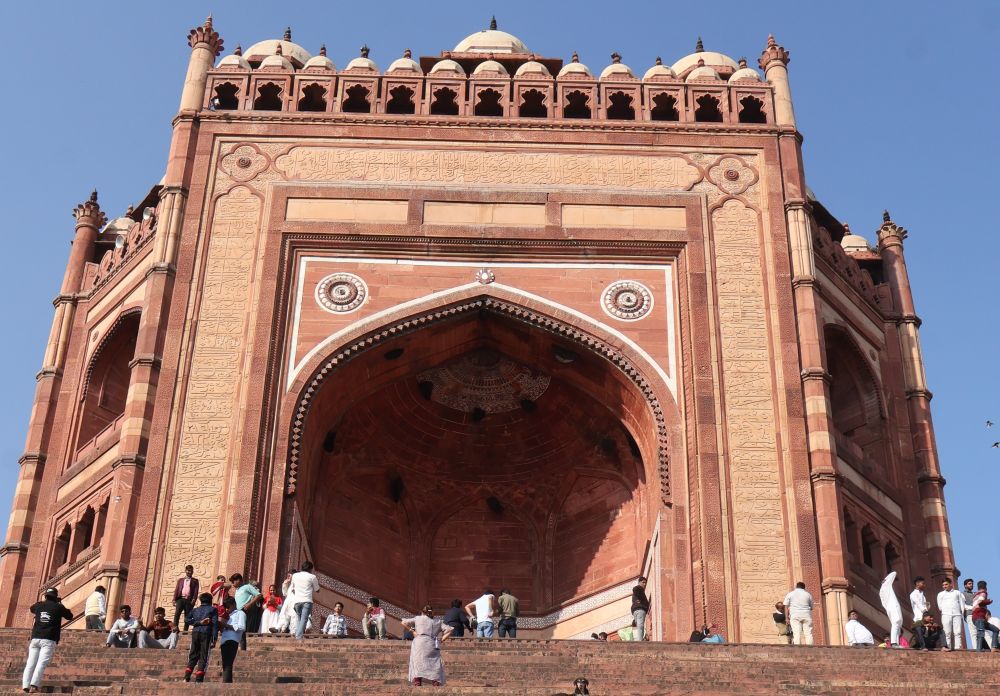
It seems that Akbar had two very different sides. One was that of a strongman: waging war, expanding his empire, and brutally executing anyone who didn’t bend to his will. This Akbar had a favorite “execution elephant,” trained to trample Akbar’s opponents on command.
The other face of Akbar was a religious man. While he was a Muslim, he appeared to respect and tolerate other religions. He tried to establish his own religion called Din-I Ilahi, which drew elements from Islam, Hinduism, Zoroastrianism and Christianity.
Akbar purportedly had three main consorts and 36 wives in total, plus a harem of thousands. He used marriage as a way to make alliances with important families. One consort/wife was Muslim, one was Hindu and one was Christian, according to the story. Curious about the Christian wife, named Maryam, I’ve spent some time searching for any kind of description of her but haven’t found one. The Hindu wife’s name was Maryam, and that name seems to have been enough for some to assume she was Christian. When I asked our guide why a Christian woman would accept being one of multiple wives, his answer was that Akbar was the emperor and he could do what he wanted. That may be true, but I doubt that any of his wives or consorts were Christians.
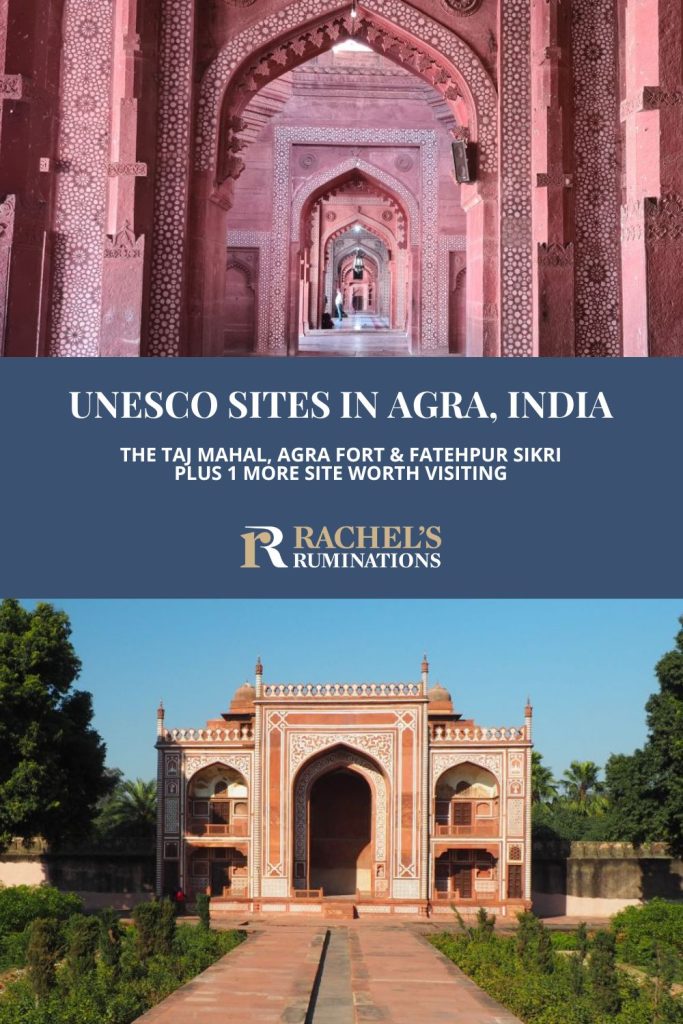
Visiting Fatehpur Sikri
Anyway, what is striking about Fatehpur Sikri is that you can spot this interest in religion in the architecture, which blends elements of Hindu, Muslim and Christian architecture. This blending of styles became the hallmark of Moghul architecture.
There are two parts to Fatehpur Sikri: the residential part, which includes the palaces of his three main wives and all the other accoutrements of a royal court, and the religious part. In the residential part, you’ll see three palaces – one for each main wife – and each is very different from the others. You’ll find Akbar’s room too, of course, which includes exits to each of the three wives’ palaces. The most ornate, and smallest, of the wives’ palaces is the little Rumi Sultana. Take a close look at the detailed stonework.
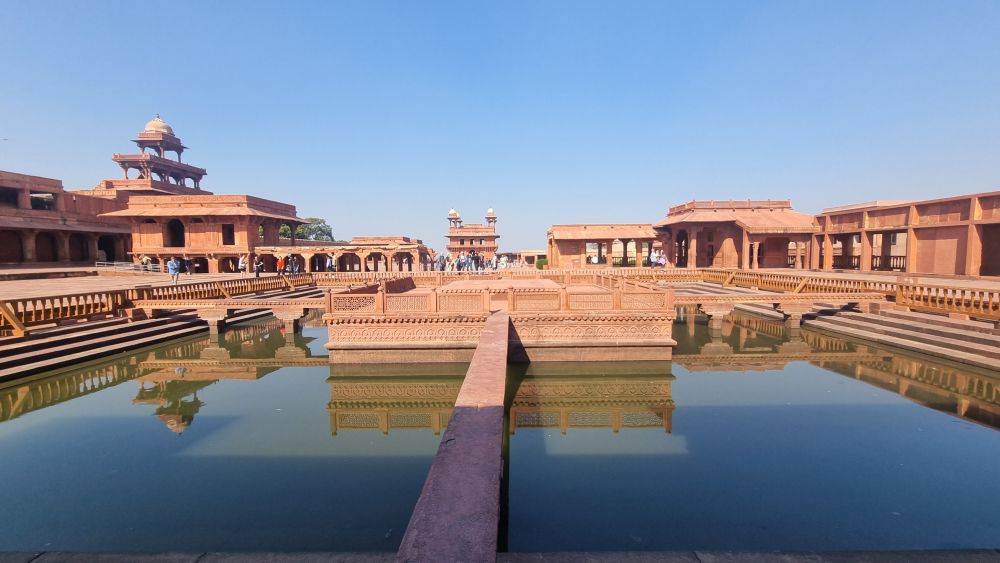
Between the buildings are various roofed pavilions and pools, meant to help ease the heat of summer.
On a large courtyard, the Hall of Public Audiences (Diwan-i-Am) is where Akbar pronounced judgment and ordered executions, which happened on the spot, sometimes using those execution elephants. The Diwan-i-Khas (Hall of Private Audiences) has an unusual design inside, with a central column on which Akbar would stand to have discussions with scholars standing in each corner at the end of four walkways.
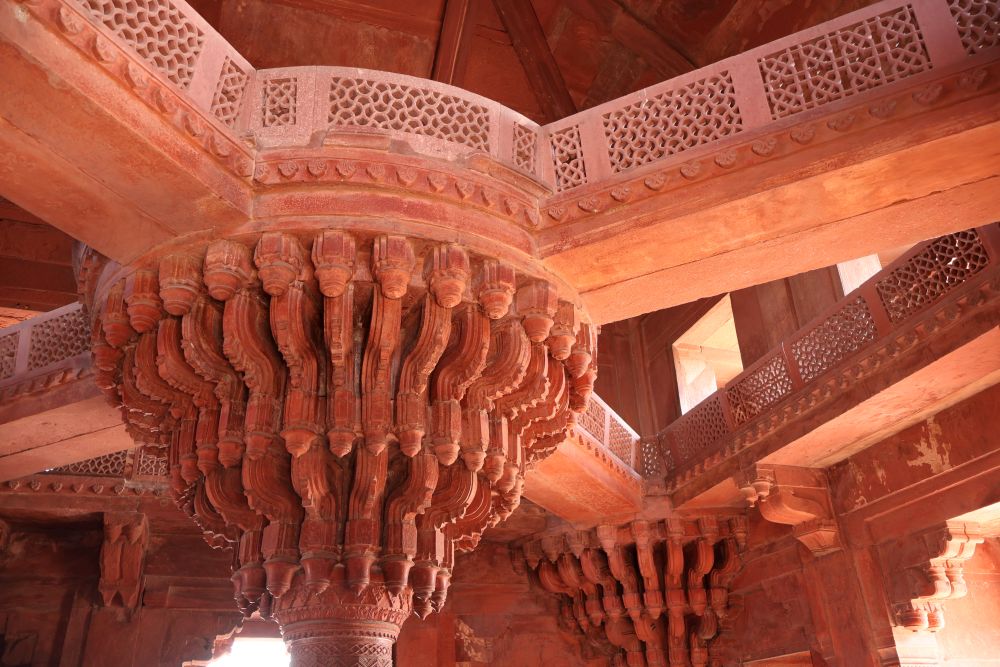
There’s more, of course: pavilions, quarters for servants and Akbar’s harem (4000 women, according to our guide), and so on.
The religious part is a vast mosque around a very large courtyard. The large gateway to enter it is called Buland Darwaza and is the largest gateway in India. You’ll have to take off your shoes before entering.
Inside the small white building near the far end of the courtyard is the tomb of the holy man. It is still an active place of worship, and you’ll see people tying pieces of string to the marble screens to represent their wishes. In the galleries inside the walls of the courtyard are small rooms that were once a madrassah – a Muslim religious school. A few of them are still used for this purpose in the mornings before regular school.
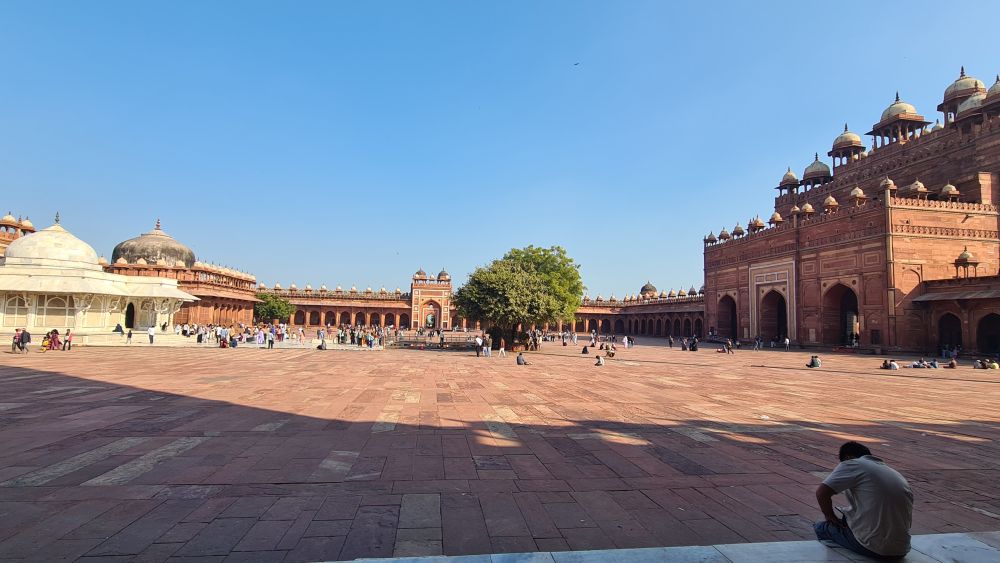
Under some of the galleries around the courtyard are tombs. These are for descendants of the holy man, who still live and work here or nearby. Among the tombs are some very insistent sellers of souvenirs.
Tips for visiting Fatehpur Sikri
To get to Fatehpur Sukri, you’ll need to either take a train, a bus, or a taxi to the town of Fatehpur. (This booking site worked well for us in India.) In theory it should take about 40 minutes, but given the general chaos on the roads, expect it to take an hour or more. The sights are up on the hill, with the city of Fatehpur below, encircled by the ancient wall. The other option is to take a guided tour with hotel pickup.
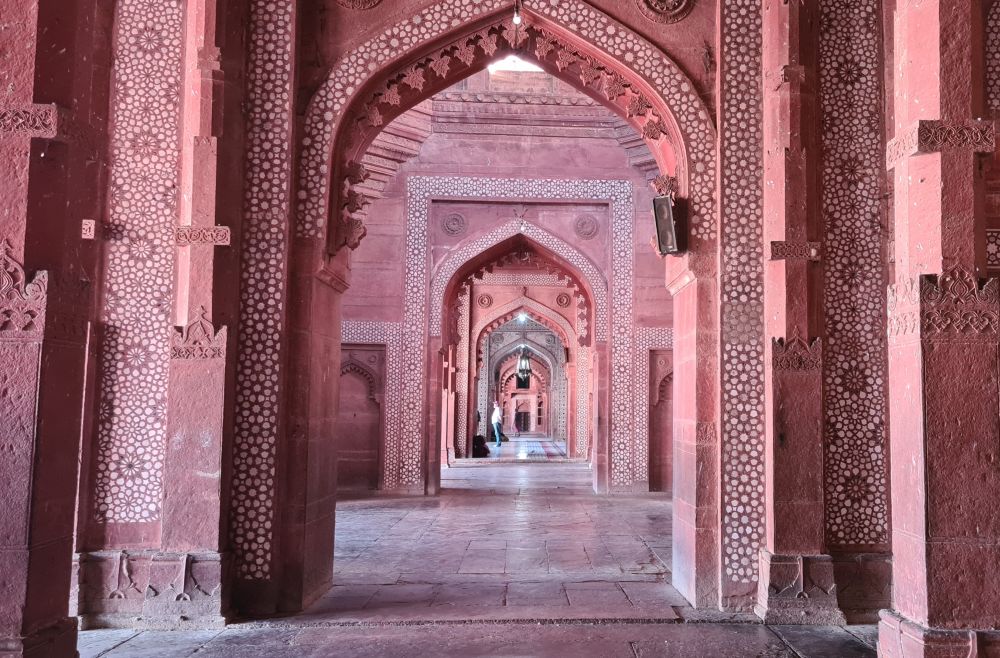
Fridays are particularly busy at Fatehpur Sikri because it’s a Muslim holy place. Having said that, we arrived after the service at the mosque on a Friday, and, while there were indeed many people there, it’s a large enough place that it didn’t feel crowded like the Taj Mahal and Agra Fort had.
Baby Taj
What is commonly referred to as the “Baby Taj” is more properly called the Tomb of I’timād-ud-Daulah. I’m adding it here because, while it is not a UNESCO site, it’s a precursor to the Taj Mahal.
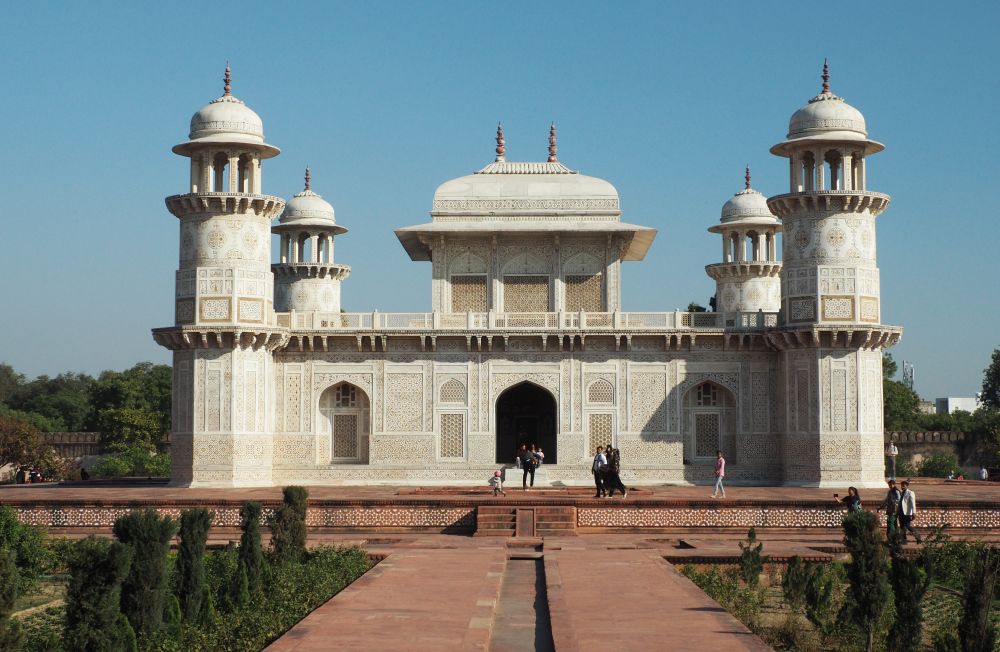
The Baby Taj was built in 1622 to 1628 out of white marble on a red sandstone base – the first white marble building. This is an intermediate stage in Mughal architecture between the primarily red sandstone architecture of Agra Fort and Fatehpur Sikr and the highest achievement of the marble Taj Mahal.
Nur Jahan, who was the wife of Akbar’s son, Jahangir, ordered the construction, to serve as a tomb for her father.
Like the Taj Mahal, Baby Taj stands in a symmetrical garden divided into four parts, with identical gateways in red sandstone on all four sides. It’s not huge, like the Taj Mahal, but you could certainly argue it’s just as beautiful – though in a very different way.
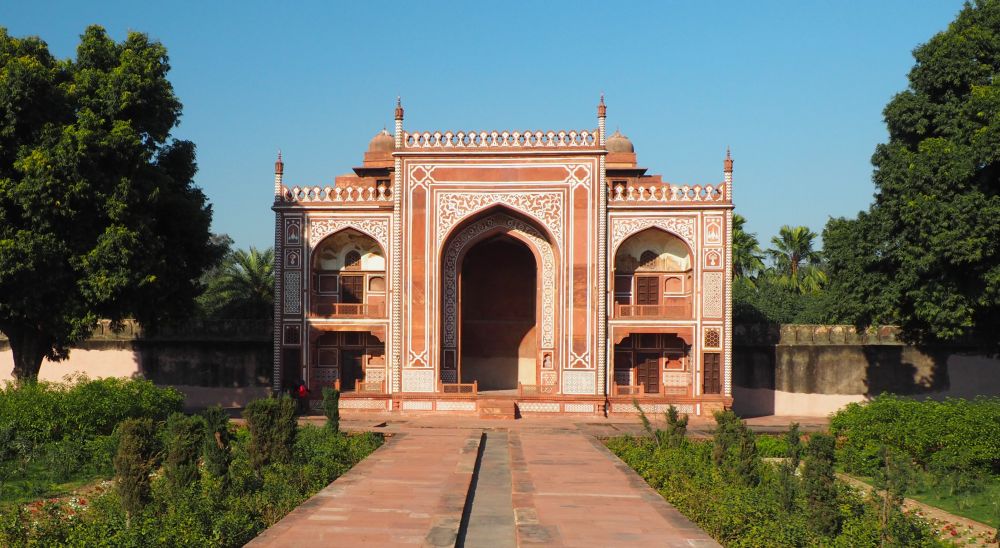
The building itself is single-story, except for the tall minaret-like towers on each corner and a high square room in the center. It’s exactly symmetrical, with the central room holding the tombs of Nur Jahan’s mother and father, four rooms around that and four square corner rooms that hold the tombs of other relatives.
The artwork inside and outside is what makes it special. It is all over the wall and ceilings, in much more detail than the Taj Mahal, both inside and outside. Outside, the artwork is mostly representations of flowers and leaves, cypress trees, wine bottles, and vases, beautifully made from inlaid semi-precious stones. Inside, the images are mostly frescos, and still in remarkable condition. Light reaches indoors through the doorways but also through finely-carved marble screens.
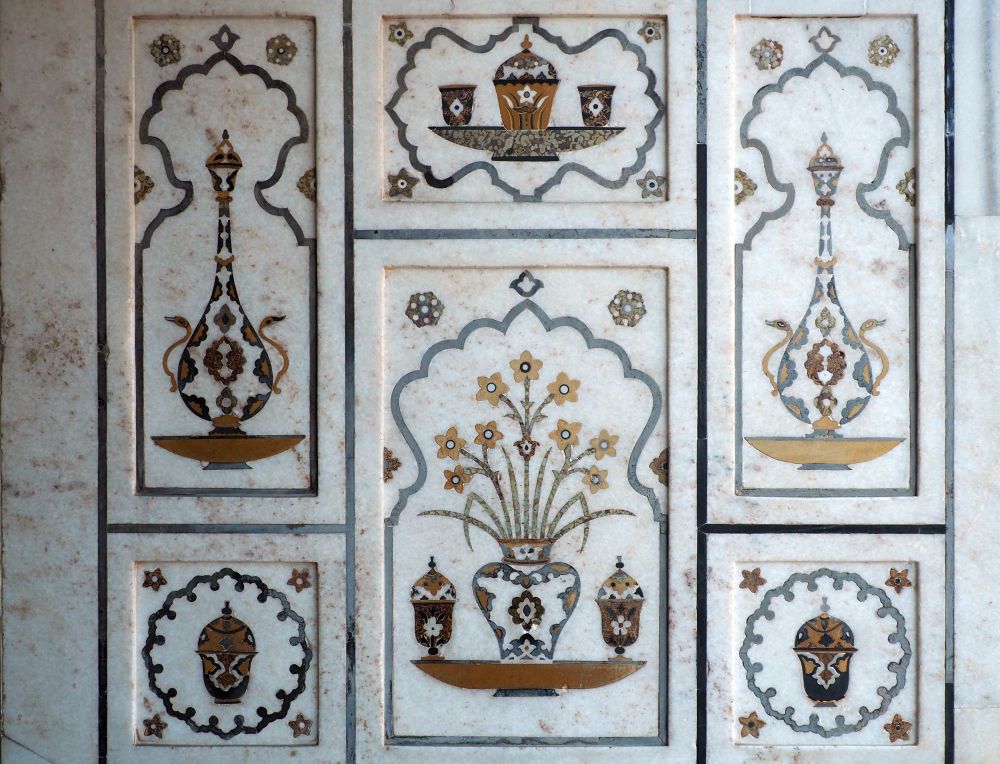
In short, it’s lovely and worth a visit.
Which Agra UNESCO sites should you see?
All of these UNESCO sites in Agra are worth visiting. If you only have a day, visit the Taj Mahal and the Red Fort. Use the metro to travel between them. At a minimum, look at the Taj Mahal toward sunset from the Mehtab Bagh across the river.
This well-rated guided tour will take to to all three UNESCO sites in one day.
If you have two days, see the Taj Mahal and the Red Fort one day. Then go out to Fatehpur Sikri on the second day and fit in a short visit to Baby Taj that day as well.
If you don’t want to do so much sightseeing, just see the Taj Mahal and Fatehpur Sikri. If you hire a taxi, it might make sense to go see Fatehpur Sikri first, in the morning, then get to the Taj about mid-afternoon. Hopefully, the crowds will be thinner by then.
Have you been to any of these Agra UNESCO sites? Please add any comments or advice below!
My travel recommendations
Planning travel
- Skyscanner is where I always start my flight searches.
- Booking.com is the company I use most for finding accommodations. If you prefer, Expedia offers more or less the same.
- Discover Cars offers an easy way to compare prices from all of the major car-rental companies in one place.
- Use Viator or GetYourGuide to find walking tours, day tours, airport pickups, city cards, tickets and whatever else you need at your destination.
- Bookmundi is great when you’re looking for a longer tour of a few days to a few weeks, private or with a group, pretty much anywhere in the world. Lots of different tour companies list their tours here, so you can comparison shop.
- GetTransfer is the place to book your airport-to-hotel transfers (and vice-versa). It’s so reassuring to have this all set up and paid for ahead of time, rather than having to make decisions after a long, tiring flight!
- Buy a GoCity Pass when you’re planning to do a lot of sightseeing on a city trip. It can save you a lot on admissions to museums and other attractions in big cities like New York and Amsterdam.
Other travel-related items
- It’s really awkward to have to rely on WIFI when you travel overseas. I’ve tried several e-sim cards, and GigSky’s e-sim was the one that was easiest to activate and use. You buy it through their app and activate it when you need it. Use the code RACHEL10 to get a 10% discount!
- Another option I just recently tried for the first time is a portable wifi modem by WifiCandy. It supports up to 8 devices and you just carry it along in your pocket or bag! If you’re traveling with a family or group, it might end up cheaper to use than an e-sim. Use the code RACHELSRUMINATIONS for a 10% discount.
- I’m a fan of SCOTTeVEST’s jackets and vests because when I wear one, I don’t have to carry a handbag. I feel like all my stuff is safer when I travel because it’s in inside pockets close to my body.
- I use ExpressVPN on my phone and laptop when I travel. It keeps me safe from hackers when I use public or hotel wifi.
